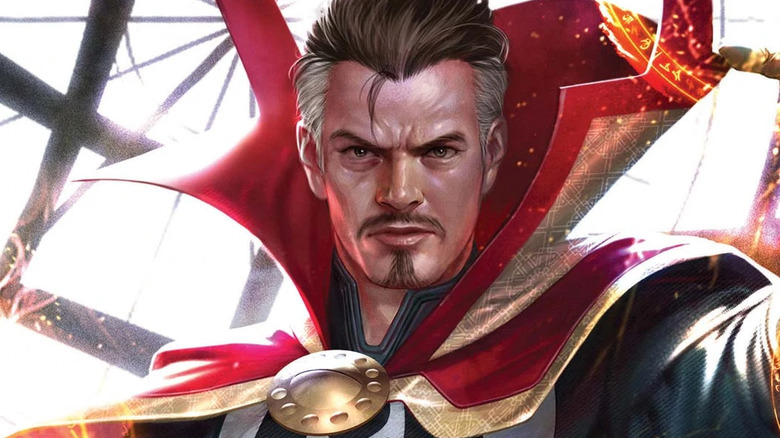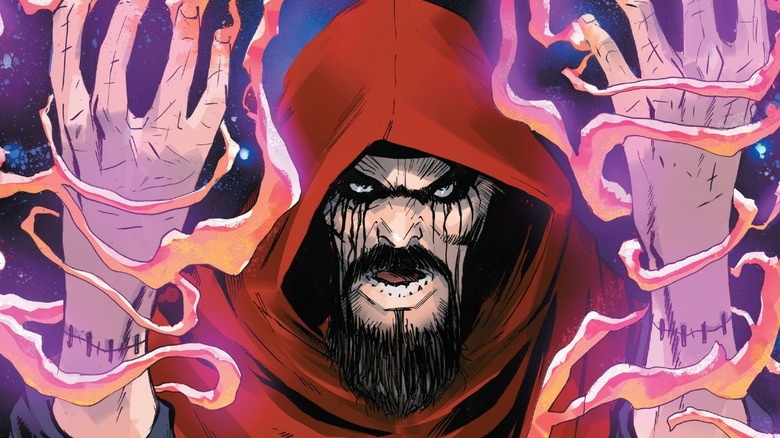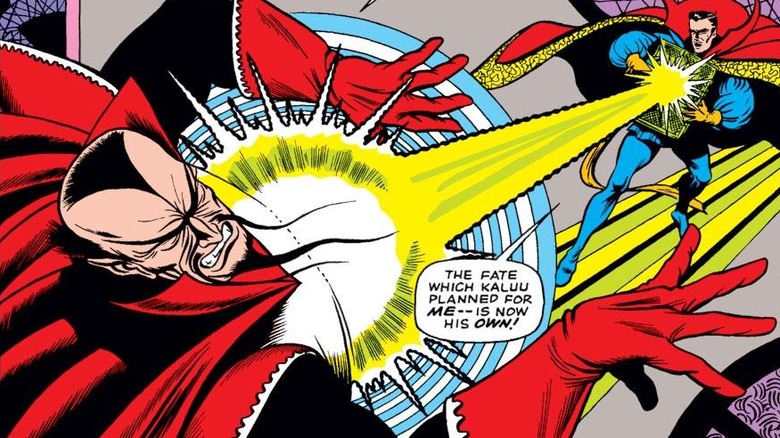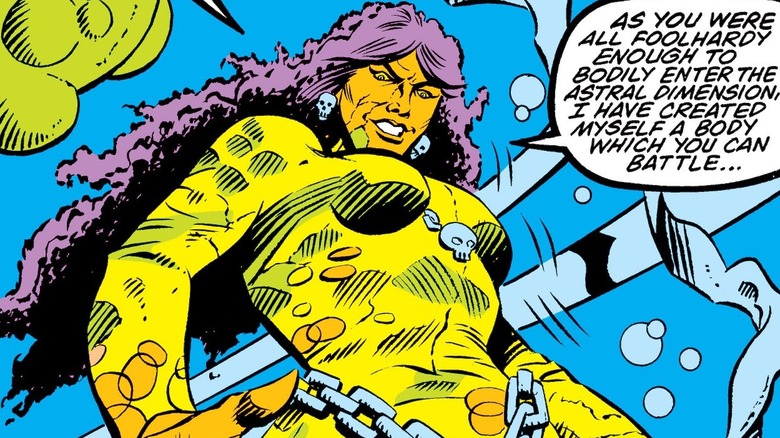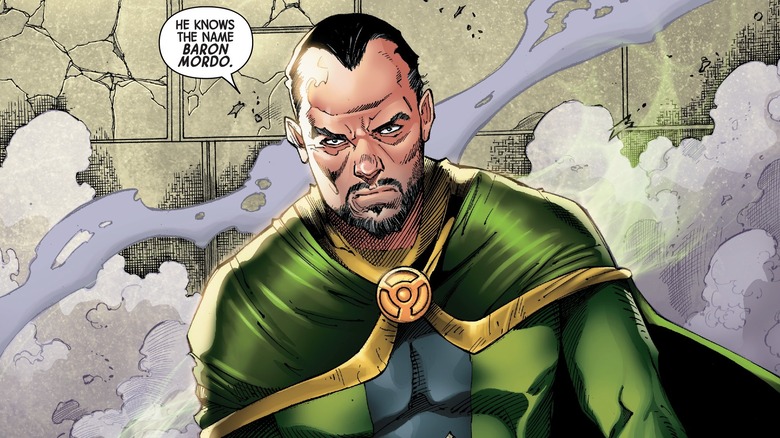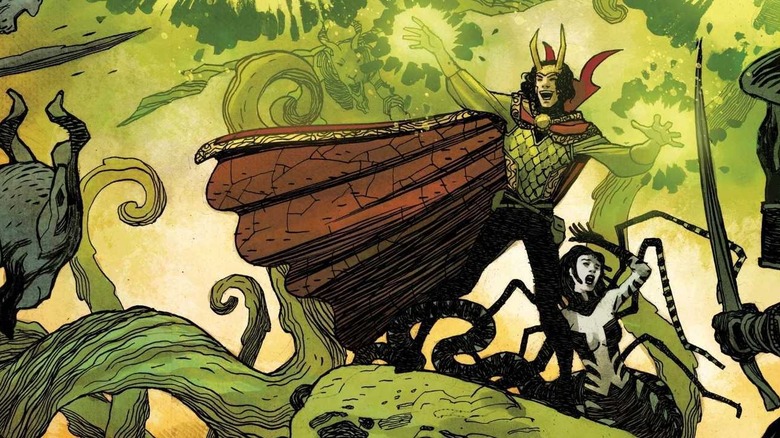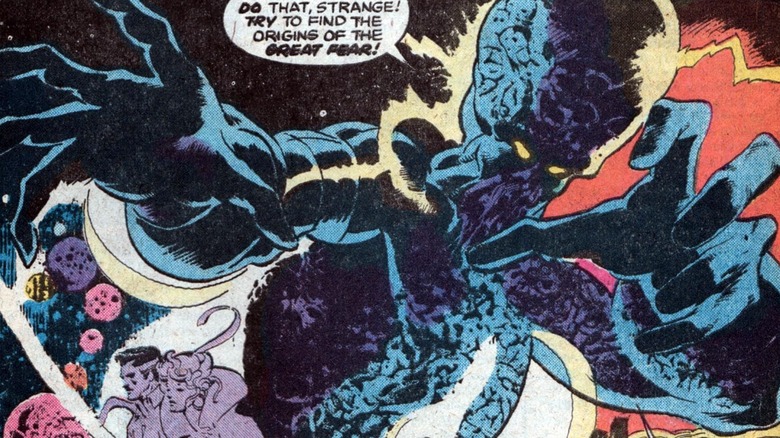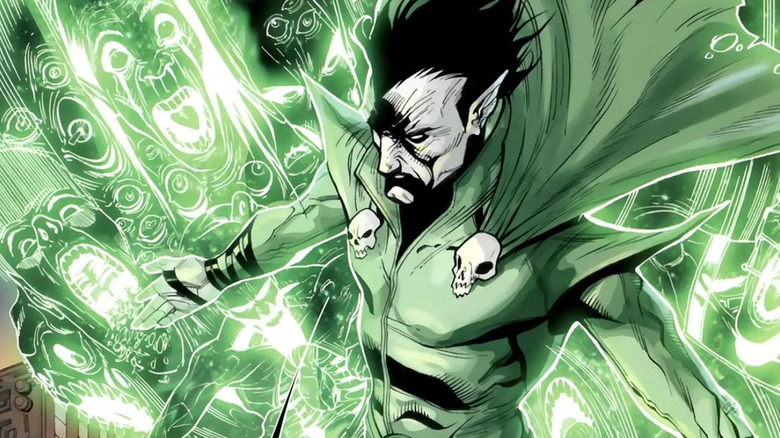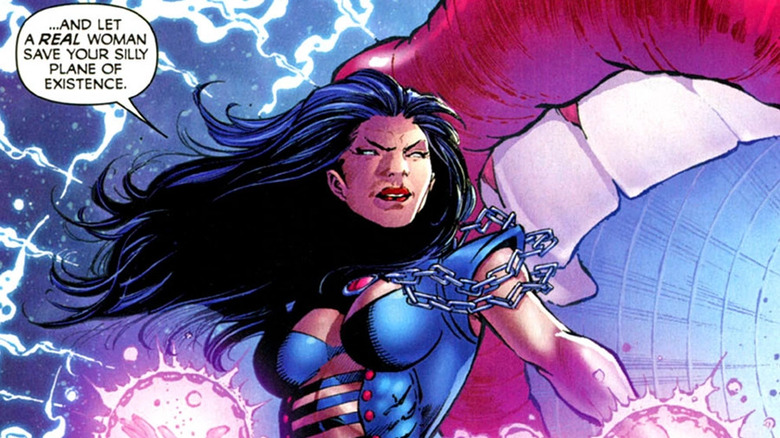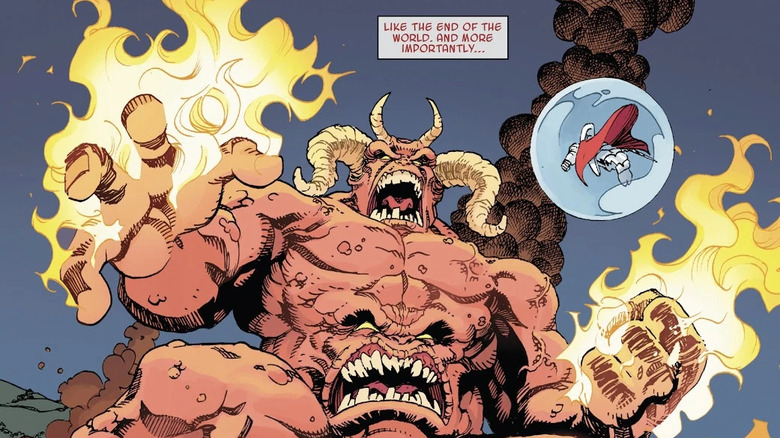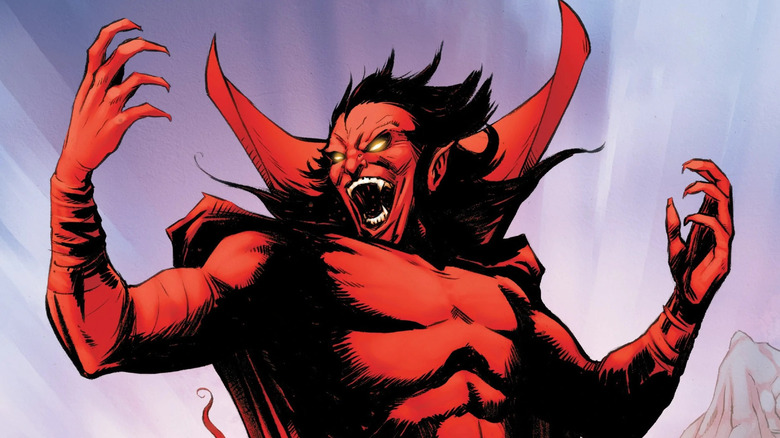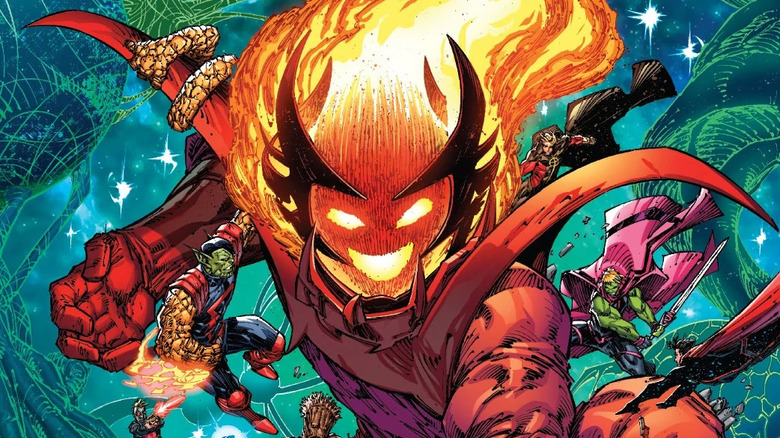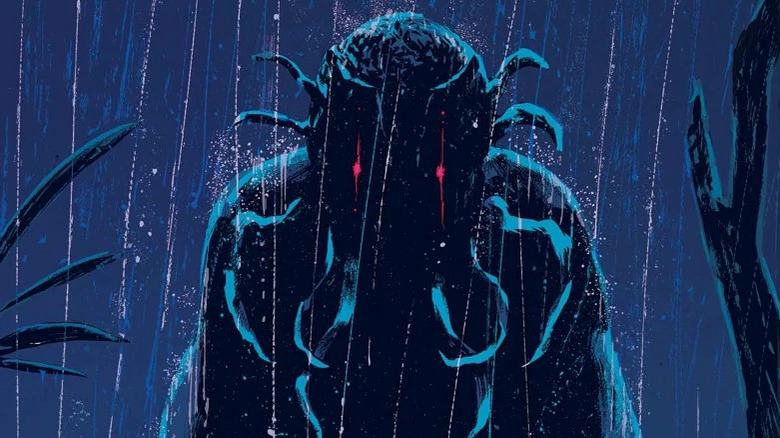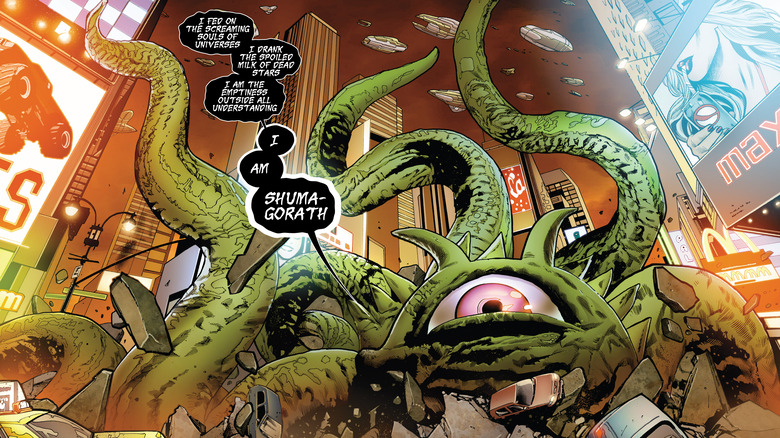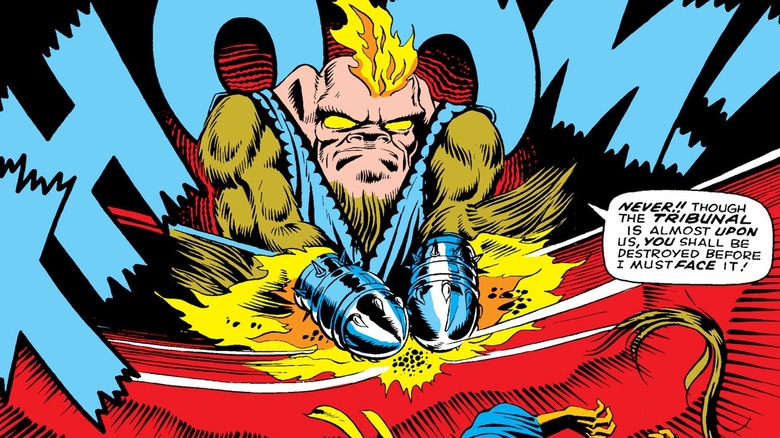Doctor Strange's Most Powerful Villains, Ranked
As Master of the Mystic Arts and Sorcerer Supreme, Doctor Strange is not a man you'd want as an enemy. In a Spring 2022 issue of Disney's D23 magazine (via The Direct), Marvel Studios producer Richie Palmer suggested he was arguably the most powerful hero in the MCU (along with Wanda Maximoff). While the comic book version of the character probably doesn't rank quite that high, it's obvious that Strange can hit as heavy as the best of them.
Of course, if you're publishing tales of an ultra-powerful sorcerer who can conjure magical weapons, project an astral form, cast illusions, and move between entire dimensions at will, you're going to need a few baddies capable of putting up a fight — and then some. Luckily, Strange's rogues' gallery is populated by all kinds of mind-bending magicians, ancient gods, and horrific demons, many of whom have given the Sorcerer Supreme a run for his money over the years. These are Doctor Strange's most powerful villains, ranked.
14. Kaecilius
MCU fans know Kaecilius as one of the antagonists in 2016's "Doctor Strange," in which he is played by "Hannibal" star Mads Mikkelsen. Although the cinematic version of the character proved to be a genuine threat for a younger, less experienced Strange, the Kaecilius of Earth-616 was initially a far less deadly foe.
Kaecilius makes his debut in 1964's "Strange Tales" #130, in which he acts as an unnamed henchman for Baron Mordo during a plot to kidnap the Ancient One. There's not much else to be said for his role in these early comics because, other than briefly becoming willingly possessed by Mordo, he actually does very little. In fact, despite appearing in more than half a dozen issues of "Strange Tales," he rarely says anything other than "I go, master" or "We hear and obey!"
Then, in 2022, a storyline titled "The Death of Doctor Strange" brought Kaecilius back and gave him a considerable upgrade, both in terms of power and importance. During this run, it's revealed that Kaecilius has been recruited by a cohort of villains to kill Strange and destroy the barrier spell protecting Earth from evil. Kaecilius successfully murders Strange, steals his soul (and hands) and frames Mordo for it all. As you may have guessed, however, it doesn't exactly stick, and Kaecilius' schemes end in his total destruction. Not exactly a rousing success for Mordo's old lackey, sure — but this is still closer to victory than many of Strange's other foes have managed.
13. Kaluu
Kamar-Taj is a crucial location in the mythos of Doctor Strange. This hidden settlement, located somewhere in the Himalayas, is home to a race of people described in "Strange Tales" #148 as "not outwardly advanced," but having "developed the arts of joyous living to a degree undreamed of by more complex civilizations." It is also the childhood home of the Ancient One himself.
During his youth, the Ancient One's closest friend was a fellow sorcerer named Kaluu. Together, they "plumbed the secrets of the supernatural," hoping to bring their people lasting prosperity and happiness. Kaluu, however, had greater designs; he established a hypnotic control over the people of Kamar-Taj, made himself king, and began to conquer neighboring villages. In the end, the Ancient One called upon "mystics powers" to defeat his old friend, accidentally decimating Kamar-Taj's populace and forcing Kaluu to escape to another dimension. Centuries later, Kaluu becomes an enemy of the Ancient One's disciple, Doctor Stephen Strange.
While he's not exactly the most reliable member of Strange's rogues' gallery, Kaluu is able to wield all kinds of impressive powers, from hypnosis to necromancy, and he even teaches Strange the ways of "black magic" in "Strange Tales" Vol. 2. The fact that he has caused real problems for both the Ancient One and Strange over the years suggests that Kaluu is more powerful than some might assume.
12. Morgan le Fay
As a former lover of Doctor Doom, a recurring enemy of the Avengers, and even an opponent of Spider-Woman, it's safe to assume that Morgan le Fay is far more than just a Doctor Strange villain. Nevertheless, she has come up against the Sorcerer Supreme every now and then. In "The Avengers" #241, she even refers to herself as "all but supreme in the arts of sorcery," and later declares Strange her "sworn enemy."
Based on the mythical Arthurian character of the same name, Marvel's Morgan le Fay also has Brythonic roots. A half-faerie, le Fay was trained in the ways of the sorcerers by Merlin and attempted to use her new powers to take the throne of Britain from King Arthur. Around this time, she gathered together the evil works of the Elder God Chthon and bound them into a single magical tome known as the Darkhold — an artifact that has caused no end of trouble for the heroes of Earth (and the heroes of the MCU).
On the few occasions that Strange and le Fay have come to blows, Strange has tended to come out on top; in "Avengers" #241, for example, he foils her attempts to possess the body of Jessica Drew and turns her to stone inside the Astral Dimension. It's a surprisingly easy finish for Strange, though you can't help the feeling that, without the Avengers by his side, things may not have turned out so well.
11. Baron Mordo
Baron Mordo is arguably Doctor Strange's most infamous enemy, and you could make a decent case for him taking the coveted title of arch-nemesis, too. First appearing all the way back in 1963's "Strange Tales" #111, Mordo is a skilled and deadly magician who once studied the ways of sorcery under the Ancient One. In his first issue, Mordo's plot to kill the Ancient One and steal his secrets is foiled by Strange, sparking a destructive rivalry that would last many decades.
In his many attempts to destroy Doctor Strange, Baron Mordo has committed all kinds of evil acts, most notably allying himself with villains such as Dormammu, Mephisto, and Hydra Supreme. Mordo has also demonstrated exactly the kind of capabilities you'd expect from one of the Ancient One's most gifted students; he can astral project, hurl energy projectiles, teleport, and cast illusions. In "Marvel Premiere" #12-13, he even briefly possesses the Book of Cagliostro, a collection of highly powerful mystic knowledge passed down from the sorcerer who gave the book his name.
It's clear enough, then, that Mordo is no run-of-the-mill magician. And though Strange has defeated him and thwarted his plans time and time again, the Baron's eternal obsession with the Sorcerer Supreme — and his innate talent for dark sorcery — makes him a tricky foe indeed.
10. Loki
Thanks to the spectacular success of the MCU, Loki Laufeyson has become one of Marvel's most iconic villains. He is best known, of course, as the arch-enemy of Thor Odinson, but the God of Mischief also has a long, complicated, and contentious history with Doctor Strange.
In their first meeting in "Strange Tales" #123, Loki attempts to deceive Strange into stealing Mjölnir, claiming that Thor has placed him in chains. Strange, displaying a pretty stunning ignorance of Norse legend, believes the Trickster God and conjures a flying metal hand that Loki uses to steal Thor's hammer. Luckily, Strange eventually figures out what's happening and engages in battle with his new enemy. After Loki gains the upper hand, Strange declares that, "Despite my mastery of the Mystic Arts, I'm still a mortal — while he — he is far, far more!" Strange only escapes with his life when Thor arrives, prompting Loki to flee back to Asgard. Strange, despondent, laments that he has never been "so close to defeat."
The two would encounter each other many times in the years to come — sometimes as enemies, sometimes as very reluctant allies. In "Doctor Strange" #381, Loki even steals the title of Sorcerer Supreme for himself, leading to a showdown from which Strange (just about) emerges victorious. A certain scene in "Thor: Ragnarok" may have many fans thinking Doctor Strange would wipe the floor with Loki in a square fight, but in the comics, at least, the truth is clearly far more complicated.
9. The Dweller-in-Darkness
You can probably tell by his name that the Dweller-in-Darkness isn't the nicest guy in the world. A member of the demonic cabal known as the Fear Lords, this extra-dimensional behemoth has murky origins and terrifying powers.
The as-yet-unseen Dweller-in-Darkness' plans are first felt in "Thor" #229-30, a story in which he attempts to create "Shade-Thralls" by tricking innocent humans into taking their own lives; only the combined efforts of Thor and Hercules are enough to save the Earth. The Dweller then appears in person in "Doctor Strange" Vol. 2 #30 — hoping to feed on their fear and escape from the ancient spell binding him in a mysterious dimension, the Dweller uses a hideous avatar to kidnap Strange and lure his love interest, Clea, into the sewers of New York. Although they manage to escape, the Dweller is freed and swears to destroy his greatest threat.
He nearly succeeds, too. From that point on, the Dweller sends a number of agents to attack and destroy Strange, and in the process, sows the seeds of fear and doubt in his mind, leading the Dweller to declare victory over Strange in "Doctor Strange" Vol. 2 #37. Although most of his comic book appearances since have seen him politicking with and against his fellow Fear Lords rather than Strange, these early battles suggest that the Dweller-in-Darkness' long game might be a little too much for Doctor Strange to handle.
8. Nightmare
Perhaps the most notorious of all the Fear Lords is Nightmare, if only because he holds the distinction of appearing in Doctor Strange's first-ever comic book story.
Back in 1963, "Strange Tales" #110 found Strange, "Master of Black Magic," investigating a man who claims to be plagued by horrifying nightmares. Strange enters the man's dreams and finds a peculiar, hooded figure — a self-professed "symbol of evil" — tormenting his inner psyche. Suddenly, Nightmare appears, and Strange recognizes him as "my ancient foe." Nightmare traps Strange's spirit inside the Dream Dimension as the man, awake and now afraid that Strange has discovered he is corrupt, attempts to take his life. Of course, Strange escapes Nightmare's clutches and returns to reality just in time, but that certainly isn't the last he sees of the so-called Lord of Dreams.
Ruling the Dream Dimension from atop his black horse, Dreamstalker, Nightmare is at his most powerful in his own realm — and it is from here that he preys on the fears and torments of the sleeping mortals he ensnares. He has encountered Doctor Strange many times since that first story, and Strange has often come out on top, too. But as long as people dream, Nightmare will survive ... and nothing Strange can possibly muster will ever destroy him for good.
7. Umar
Umar is among the most significant villains in Doctor Strange's rogues' gallery, and although she is less well-known — and arguably less powerful — than her brother, Dormammu, she has nonetheless been a thorn in the Sorcerer Supreme's side for many years.
Both Umar and her brother are beings of immense magical power known as Faltinians. Exiled from their home reality for destroying their father, they arrived in the Dark Dimension, conquered it, and made it their own. Dormammu then claimed total authority over the realm and, disturbed by his sister's ambitions, banished Umar to a pocket dimension.
Umar herself is introduced in "Strange Tales" #150. Since Dormammu was previously vanquished by the cosmic being known as Eternity, the spell that binds Umar to her prison is relinquished. She claims the throne of the Dark Dimension and sets out on a rampage of revenge against her brother's nemesis, Doctor Strange. She proves to be more than a match for him, too. In "Strange Tales" #152, Strange briefly fights Umar one-on-one, only barely escaping with his life, and, in "Strange Tales" #156, he is only able to defeat her invasion of Earth by unleashing a far more terrifying being.
Umar has returned for many stories since that early run, most often coming into conflict with her daughter, Clea, as well as Dormammu and Strange. She may not quite have the edge over her unholy older brother, but she is still as cunning, as powerful, and as dangerous as mystic Marvel villains get.
6. Satannish
Along with other demons such as Mephisto, Hela, Beelzeboul, Lucifer, and Thog the Nether-Spawn, Satannish the Supreme is one of the powerful Hell-Lords who have contributed to the popular human notion of "Satan." This monstrous, pale-green beast was, according to "Hellcat" #2, created by Dormammu as a means of infiltrating the Hell-Lords and claiming their realms for his own.
In his first appearance in "Doctor Strange" #174, Satannish is revealed to be the hidden master of Lord Nekron, a powerful magician who bargained his soul for more abilities. Nekron subsequently attempts to deceive Strange into taking his place as eternal servant to the demon. Notably, Strange only defeats Nekron in this issue, while Satannish himself is depicted as far too powerful to face in single combat.
If this all sounds a lot like just another demonic deal-making Marvel villain, there's a very good reason for that. As revealed in "Doctor Strange: Sorcerer Supreme" #8, Satannish and Mephisto once formed part of the same demonic entity. Since splitting, they have engaged in a bitter rivalry — one that seems to come to an end in "X-Factor" #254, when Mephisto strikes down and apparently imprisons Satannish in his own realm. He hasn't been seen since.
5. Mephisto
Mephisto is one of Marvel's baddest baddies. Enjoying a history that goes back to the late 1960s, this Faustian demon has since become a sworn enemy to all kinds of heroes, including Ghost Rider, Spider-Man, Thor, the Fantastic Four, and, of course, Doctor Strange.
During his seemingly eternal quest to enslave as many human souls as possible in the realm he calls "Hell," Mephisto has frequently faced off with the Sorcerer Supreme. Their early confrontations were hard-fought and brutal; for example, in "Doctor Strange" Vol. 2 #16, Strange pops an unnamed Satan-like demon — likely Mephisto — "not unlike a bubble." Later, though, their encounters tend to be a little more civilized. In "Doctor Strange: Damnation" #1, Mephisto and Strange play a game of blackjack for the souls of the people of Las Vegas. Later, in the "Sinister War" storyline in "Amazing Spider-Man" Vol. 5, the two old foes play another fateful game of chance, one that ends with the freeing of Harry Osborn's soul.
But this doesn't mean Mephisto can't beat Strange in an all-out fight. It simply means that, for some reason, Strange has felt the need to meet his enemy on his home turf — that is, gambling for the eternal souls of humans. The fact that Strange is able to escape with his own soul intact, much less those of his fellow mortals, is truly remarkable.
4. Dormammu
Described by Marvel as "one of the greatest forces of evil in the universe," Dormammu is one of the few villains who can lay claim to being Doctor Strange's archenemy. The ruler of the Dark Dimension was, according to "500 Comic Book Villains" by Mike Conroy, created by Stan Lee and Steve Ditko as little more than world-building fluff, a name Doctor Strange could invoke when casting the odd spell. Before long, though, readers were demanding to know more. "I knew I was in big trouble," Lee recalled. "I had made up the name — now I had to dream up a character to go with the name."
Lee and Ditko dreamed up quite the character. Dormammu is as close to pure evil as any Marvel villain, existing as the utter embodiment of chaos, darkness, and despair. He is also immensely powerful; in his first full appearance in "Strange Tales" #126-7, Strange is quickly overwhelmed by Dormammu's power and only spared when the threat of the rampaging Mindless Ones forces the two to join forces.
But Dormammu's power can be measured against more than just Strange. As the creator and manipulator of Satannish, he arguably dwarfs the Hell-Lords in terms of sheer strength. He's also held his own against Agomotto, who, in "Doctor Strange: Sorcerer Supreme" #43, holds his own against Galactus. Moreover, in "Defenders" Vol. 3 #3, Dormammu overcomes and defeats the universal power known as Eternity. And the real kicker? This guy doesn't even make the top three.
3. Chthon
Long ago, the mysterious life-force known as the Demiurge seeded the Earth with fragments of its own essence, giving birth to the Elder Gods. This race of incredibly powerful cosmic beings included Gaea, Mother Earth; Set, the Great Destroyer; Oshtur; Goddess of Truth; and Chthon, the Sleeper.
Chthon was already the Earth's first master of black magic, but things got worse when all the Elder Gods (save Gaea) began to degenerate into demons. Gaea responded by giving birth to the god-killer, Atum, while Chthon wrote down everything he knew onto parchments that would later become the Darkhold. In doing so, he set the world and its inhabitants on a very grim path, indeed.
Chthon's storyline is most closely associated with Wanda Maximoff, who, in "Avengers" #185-7, he attempts to use as a vessel through which he can be summoned back to Earth. But he has also fought Strange — in a sense. Their battles have always involved Strange attempting to prevent Chthon's reemergence by breaking his possession over mortals, such as in "Doctor Strange: Sorcerer Supreme" #90, when he saves Victoria Montesi from giving birth to Cthon, or in "Secret Empire" #7, in which he breaks the demon's hold over Wanda. These weren't full fights, though. In fact, as of "Darkhold Omega" #1, Scarlet Witch is the only being to have ever faced Chthon's true form and come out on top. Could Strange hold his ground against him, too? It's hard to say — but it seems doubtful.
2. Shuma-Gorath
In "Mighty Avengers" Vol. 2 #2, Doctor Strange is forced by Ebony Maw to summon a tiny fragment of the being known as Shuma-Gorath into Manhattan. "Before all was," the creature declares, "I was. Before time was, I waited. I fed on the screaming souls of universes. I drank the spoiled milk of dead stars. I am the emptiness outside all understanding. I am Shuma-Gorath ... and the world is mine."
Heck of an intro, and ol' Shoomy-Gory ain't exaggerating, either. One of the so-called "Great Old Ones" who ruled the Earth millions of years ago, Shuma-Gorath is a being of unimaginable horror. Although it was banished to another dimension by the time-traveling sorcerer known as Sise-Neg, the demon has since attempted to return to its old stalking ground, enlisting the aid of hordes of monstrous servants in order to do so. Its in-person debut can be found in "Marvel Premiere" #10, a story that ends with Strange killing the Ancient One in order to stop Shuma-Gorath from using his mind as a trans-dimensional portal.
It's hard to overstate Shuma-Gorath's power. In "Strange Tales" Vol. 2 #14, it is even suggested that this "infinite" demon, "ruler of hundreds of dimensions," has the ability to destroy entire worlds — and more — with a wave of its tentacles. "I am nothing except my power," it tells Strange in that same issue. It's not wrong there.
1. Zom
Wait, what? Who's Zom? And how could he possibly be Doctor Strange's most powerful enemy?
Well, although he has only made a few appearances in Marvel Comics and only shows up in his full form once, the truth is that this is a being of unimaginable power. "Strange Tales" #156-7 mostly involves Strange attempting to defeat a newly emerged Umar and prevent her invasion of Earth. To that end, Strange and the Ancient One summon Zom, a grotesque being who was apparently once imprisoned in the "Timeless Amphora" by the combined might of Eternity and Dormammu, who were unable to destroy him outright. Zom is intimidating enough to send Umar running back to the Dark Dimension almost immediately, but that isn't the end of the story — not by a long shot.
Zom, who admits he was "created to destroy," embarks on a full-blown rampage with the intention of killing Strange and the Ancient One, wiping out mankind, and swiftly moving on to other worlds. It's only with the arrival of the Living Tribunal, by far one of the most powerful entities in the Marvel Universe, that Zom is banished once more, and even then it takes some convincing to prevent the Tribunal from simply annihilating the Earth to remove the contamination of Zom's presence. Only fragments of Zom, known as "Zomlings," have emerged since then, and it's a good thing, too — it stands to reason that the return of Zom could threaten the fabric of reality itself.
